Model Engine Gallery Page 12
Click on the images to view them larger size.
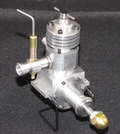
|
Here's a PMC IMP made from the first free plan issued to Model Engine News Members. It was built by Gail Graham who has now made three of them, each with slight variations, such as different mounting lugs and transposition of exhaust and inlet to amore conventional orientation. Gail reports that the IMP will spin a 7x4 at 9,060 and a 6x3 at 10,900—which says a lot for the fits and workmanship. Don't know how long it will last, but there's a uTube video available of it spinning the 7x4 with that lovely brap, brap diesel sound. Great effort, and great to know engines are being made from the free Members' plans. |
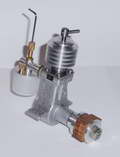
|
This Deezil was made from Classic Model Engines castings by Jim Frew, Dorset, UK. As well as saying nice things about this website (thus guarenteeing his photo a place in The Gallery, Jim confessed that building it caused his scrap box to increase in size somewhat, but the sound and smell of the Deezil running made it more than worthwhile. Those who have done this will agree and smile at their own memory of that moment; those who have not have it to look forward to. Pay close attention to the quality of the work around the needle valve and venturi. This sort of attention to detail ndicates a mind-set that tends to permeate all of a builder's work and virtually assures success, regardless of how may parts are rejected along the way. |
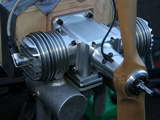

|
Here's a nice twin from Phil Wilson, of Somerset, England. As well as being an accomplished builder, Phil knows how to get a picture past the editor. Here's what he says:
Seeing as you are a self confessed sucker for a twin, and seeing as you (along with David Owen) hooked me on engine building, I thought that I would send you a couple of pics of my latest creation (the first being a Mate). Not a diesel, I know, and perhaps a bit big for your liking, but I think own designed engines are probably like babies - we all think ours is beautiful, but probably nobody else does. I have got a 2.6m wing span radio controlled Sukhoi waiting for it. I have it running with a commercial CDI ignition, and a Walbro carb. It has a cast iron cylinder liner and the piston rings were made using the simple technique, attributed to Les Stone, that you describe on your web site, so I can confirm that that method really does work. So far, after three hours running, it has reached 5000 rpm with a 27x10" prop.
|
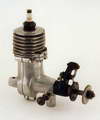
|
This one-off sparkie of about 2cc displacement is the work of PE Norman, and yes, that PE Norman: he of the pendulum controlled, free-flight scale WWI biplanes and the very, very early free flight and single channel R/C ducted fan models! I was not even aware that he was a model engineer until Ken Croft sent these photos. You can read Ken's account and see more details on the PE Norman Sparkie page. |
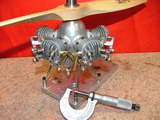
|
This Morton M5 was built by Al Raybone from the parts available Vernal Engineering (Bruce Satra). Al used the redesign effort Bruce has poured into this design to produce an engine that spins at 5,100 rpm on glow ignition with 15% nitro and 18% oil in the fuel. If an original Morton was coaxed to this speed, it would probably have self-destructed soon thereafter! Al was nice enough to say that he would never have considered tackling the project before he read the M5 Build Project Notes on the Model Engine News website. |
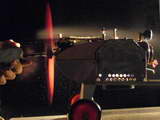
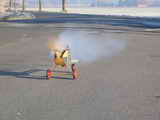
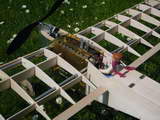
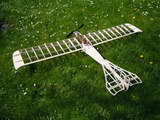
|
This flash steam power plant for aero use is being developed by Martin Elmstetten of Dortmund, Germany. Here is his description of progress to date:
Please excuse my rusty English, I haven`t written in English for quiet a while.
Here are some more details about my project:
The Saito V4 steam engine used in the test trike is single-acting 2.5 cc (9x10 mm) and will turn a 11x6 prop at 3000 rpm with 2,5 atm (36 psi) steam pressure. It`s interesting to compare this with the Pachasa air engine test results. My goal is to turn a 12x8 " prop at 3500 rpm plus with one 2.25 cc (13x17 mm) double acting cylinder working at 3.5 atm (51 psi) pressure. The tests showed that if the steam pressure is halved or doubled, the static thrust of the prop will also be halved or doubled with the rpm changing with square root of two. The tests also proved the theory that steam engines work more efficiently under load and also that larger propellers work more efficiently than smaller ones. The mechanical efficiency with a 12x8 slow-fly prop was 60% , but with a 9x4 prop only 25% ! If the load is too light the engine will speed up, throttle itself and most of the steam will rush through the cylinders without doing much work. The limit for the useful piston speed is the cross section of the steam ports in relation to the piston era. According to my tests, if the port era is 2% off the piston era, the highest point of the power curve is at approx. 1 metre/sec piston speed, regardless of the stroke of the engine. Doubling the port era will double the potential useful piston speed. The main problem is, of course, to maintain steam pressure for more than a few seconds! The propeller wind can be used to assist the combustion using an air scoop but also tends to carry away a lot of the heat generated by the burner. Think of trying to get some water cooking outdoor with a camping stove in a cold wind, you know what I mean! My latest burner is a 12-wick alcohol burner weighting 105 grams which will generate 4-5 kw heat for four minutes, this is the biggest and hottest fire I can get into the firebox. One problem is if the fire is forced too much the flames will tend to burn ABOVE the boiler instead of underneath it, the other one is the priming (carry over of water in the steam) when the boiler is forced hard. Wing span of the aircraft is 1,85 m (6 feet); starting weight will be approx. 1.6 kg (3-1/2 lb). |
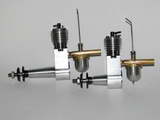
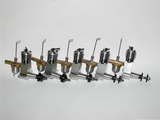
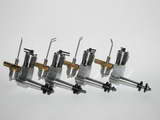
|
These engines were built by Eric Offen (UK). The subject is the Allouchery 0.7cc diesel from the 1940's and Eric ably demonstrates that after you have set up to make one of something, two of the same something is no where near twice the effort, nor is four, or apparently, ten! The Allouchery was one of the earliest mass produced diesels and many believe the larger Allouchery 1,25cc was the template for the Mk I Mills 1.3 due to the obvious similarities, although evidence provided by the dates on the Mills patents convincingly argue that this was not the case. Anyway, Eric made his 0.7cc versions from original material found in the Miguel deRancougne Collection and has done his usual magnificant job (just look at the tank tops as a small example) and built five each of the long and short shaft variants. Want to bet they run as good as they look? |

|
This montage shows the engines built by Motor Boy, Ken Croft. It's not quite complete as it shows 38 designs and Ken knows he's made 40, producing his own sand and die castings for many of them. The photo even shows the order they were built in, left to right, top to bottom. Only the Chenery side-valve remains unfinished, showing Ken's preference for two-strokes, generally of obscure or unusual design. How many can you identify? |
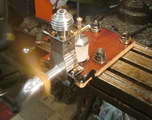
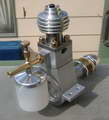

|
Seems Rob Jenkins (Australia) likes big, loud, diesel thumpers made from solid aluminium blocks. Following his Sparey 5, he's just completed a "Double Dyno" from plans that appeared in SIC quite some time back. And in case you can't figure it out fron the name, it's a twice size Dyno, the second commercial compression ignition engine to be manufactured in some quantity. Rob says he initially had some trouble with getting it going due to the straight-through venturi shown on the plans. While test running it (top photo, before bead-blasting, with the black gunge that is quite normal for the first runs of a new "TDC pinch" diesel), Rob found it picked up if he partially obscured the inlet. After experimenting with inserts based information in our MBI Book, he has it running much better.
It still needs a "proper" compression adjustment screw, and will now start first flick when warm, but needs two fingers and solid flick when cold, leading to Rob retiring, hurt, with a purple starting finger (how well I know that feeling). His final comment on it is bloody loud!!! |
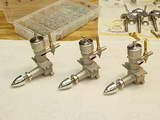
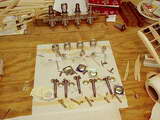
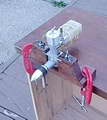
|
The world's supply of AHC Diesels has just increased by five thanks to Randy Ryan. Randy built them exactly to the CAD plans I drew way back, using scraps of information and a photo of the only finished prototype engine know to exist (the photo that is—we've no idea what happened to the prototype).
Like the ones I made, Rany reports that all of his AHCs started easily and handle well, although they tend to sag slightly after they heat up. I found this with all the ones I made too, including the rear inlet ones. But based on a statistically suspect sample of one, this trait is cured by the updraft variant. Unfortunately Randy has no more cases, so he can't try the experiment to verify my hypothisis |
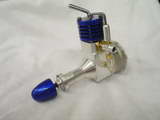
|
This picture-perfect example of the ML Midge was built by Aaron Novak (USA) from the MBI Imperial measurement redraw of the original metric plans from Mark Lobbock. Aaron's day job involves engine design ar Mercury Marine and he has recently been contributing to the improvements in Burce Satra's Super Morton series. |

|
Here's a very nicely presented antique-look, water-cooled, side-port, spark ignition, two-stroke, designed by Nick Rowland (USA). It is "square" with a bore and stroke of 7/8" for a displacement of 0.526 cuin (about 8.5cc) and seems to have a little fan in front of the cylinder as well. Nick's website says that plans, castings, and finished engines will be available.
If you visit any "20MegsFree" pages, make sure your popup blocker is switched on and be careful where you click—the website host provider is, shall we say a wee bit pro-active? |
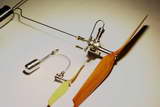
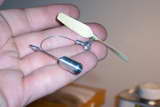
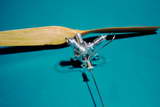
|
These masterly examples of engineering in miniature are the work of Gerard Moore. They are based on the basic CO2 design developed by Stephan Gasparin and employed in his myriad single and multi-cylinder configurations. Gerard says:
A few months ago you were kind enough to reply to my query regarding the manufacture of small ball ended conrods. Well, I finally have finished the little beasty that they were intended for. The design is based on Stephan Gasparins G28 motor, all parts being made by me on my Myford ML7, which is probably a bit on the large size for making such little things.
The bore is 2.85mm, Stroke 4.5mm that gives a total volume of 56 cubic millimetres. Tank capacity 3 cc, Flying weight 10.4 grams. Construction is all aluminium except for the crankshaft (Silver steel), Conrods (Brass) and crankshaft bearing (phos-bronze). Piston skirts and valves are made of Acetal. It runs for 2 minutes on a full liquid charge on a moderate to high power setting. RPM is in the region of 4,500 at the beginning of the run. This is my first ever home made motor and I certainly have learnt a lot. Total constuction time spanned 5 weeks. Following this I rashly offered to repair a fellow modellers Gasparin G2.6 co2 motor that required a new piston, the original one having been lost after the conrod no longer remained attached to its socket. This motor has a bore of 1.6mm and a stroke of 1.3mm. I surprised myself by successfully making a new one first time round. The end result of this is that I have also now built a reproduction of this motor! I've been trying to take some pictures but my camera is struggling to focus properly on it! Drilling the exhaust ports was a challenge. It required a home made drill bit 0.15mm diameter and a magnifier! |
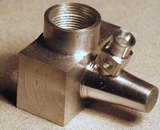
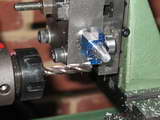
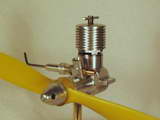
|
First, have a quick look that this link to a home-made Dart. Here's another from the same builder, Mark Lester (UK), made to replace the other one after it went bye-bye in a free-flight model. The fly-away occurred in June 2006 and the replacement was started in December of the same year, being finished in March 2008 (one can't rush these things  ). ).
The photos also show Mark's milling set-up for the crankcase and his glued-in venturi. The strength of the joint relies on the area of contact, which is not large in a small engine. In fact, Mark reports that he has subsequently had to re-join and reinforce the venturi with JB Weld. The material Mark chose for the con rod is worth mention to: he cut it from a worn out, forget aluminium bicycle sprocket wheel. I rather like this idea, although I'm not convinced it given the benefit you might think (see the April 2008 Tech Tip. |
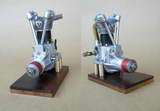

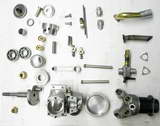
|
Model radial engines, especially scale radials, are a joy to look at but a massive undertaking to build. One toe-in-the-water offered by Vernal Engineering is a single cylinder four-stroke based on the Bob Roach designed Pratt and Whitney Jr cylinder for which Vernal offers beautifully crafted investment castings. Building one of these is still a significant achievement, but not so daunting as the complete radial project. This approach has an added advantage because by the time you are done, you are either cured, or hooked!
This example was built by Mitch Sherve of North Carolina, USA. Mitch's engine is all the more impressive because this was not only his first model engine project, it was also the first time he had touched a machine tool! Mitch chose the glow ignition option (higher compression ratio than the spark ignition version) and reports that the engine fired up straight away, spinning a 12x6 with authority on a 10% nitro mix. The vital stats are 0.875" bore with a stroke of 0.944" for a displacement of 0.56 cuin. Bruce Satra, chief cook and bottle washer at Vernal, offers many ready made components for the engine as well as the raw castings. |
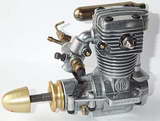
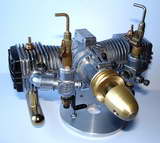
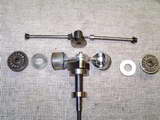
|
This boxer twin is the work of Dietmar Kolb. It is a 6,92 cc flat twin, made of two HP (Hirtenberger) VT21's. Dietmar says that is was relative easy to produce since the crankcase of the engine is split horizontally on the thrust line, allowing the two upper halves to be bolted together to form the basic configuration for an opposed, alternate firing, four-stroke twin. Dietmar made a new crankshaft and conrods, and changed the location of the exhaust and inlet pipes and the glowplug.
The lower photo shows the drive train with fork and blade conrod big ends and the standard HP follower shaft with bevel gears that provides the drive to the rotary valve head. As I discovered several years ago, the alternate firing, horizontally opposed four-stroke is not as awful as it sounds (see the October 2002 and November 2002 MEN issues). While the reciprocating mass is out of phase, the arrangement allows more even distribution of the power strokes. This is not an option for a crankcase scavenged two-stroke though, for reasons that I hope are obvious. |
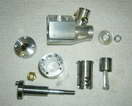
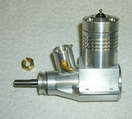
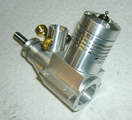
|
Here's another one from John Lorbiecki; the heritage to his previous Schnurle ported RRV engine is obvious, once you know to look. John says:
Well, it has been a cold winter, so I thought since I had made a rear rotor engine, I would try a front rotor engine. This one is also a .19, with the same square bore/stroke as the other (625" x .625") as I had most of the old tooling. It is a dual ball bearing model, with a 1/4" front bearing and a 12 mm rear bearing. The piston is cast iron again and the liner is steel. After doing all the design on the engine and then fabricating the bottom end, it ended up looking just like a big version of a Tee Dee! Hmmm, there must be something functional in how Cox originally designed their engines and I must have subconsciously copied it. The crank is made from steel and has a .1870" diameter crank pin. The rod is aluminum as is the majority of the engine. The backplate is held in place with 4 4-40 screws and the head/liner/cylinder is held down with 4 4-40 screws. Again, for simplicity, I used a standard long reach plug. It is again Schnuerle ported with a simple semi hemi head. The rear bearing is pretty much junk and I have a new one coming. But all in all, for a very small amount of material (and a bit more time) I have a cool looking addition. Will hope to run both if the weather ever gets above zero... |
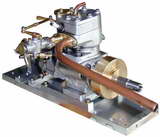
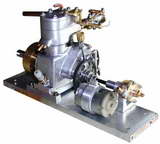

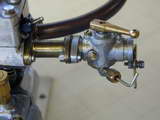
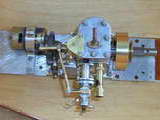
|
Here is Malcolm Beak's take on the ETW Whippet, built in 2004. The engine is close to what might be termed a "power egg", having almost all the running bits mounted on a baseplate that can be swapped between models. Most obvious is the electric starter added to the anti-flywheel side. He has also transposed the inlet and exhaust valves so the exhaust can more easily be directed aft. ETW allowed for this, though it does mead re-phasing the cams. The reason the carby is extended is because Malcolm wanted more clearance between it and the plug (a fact I've discovered on my own examples of the engine).
Less obvious is the fact that while still 10cc, this has been achieved using a different bore and stroke. If you've read my build notes in detail, you may recall that I'd found the cylinder bolt bosses and dimples in the head were so badly out of place that if used, would result in two of the bolts intersecting the liner. Here's what Malcolm found:
Those head bolts! My order of building was to finish most of the castings before starting the internals. So I had drilled the holes in the centre of the cover bosses, and of course when I spotted through, they were obviously going to break into the liner flange (I had already bored the block for the liner). After some serious cursing and thought I decided to reduce the bore to 7/8" and increase the stroke to 1", so the capacity was still 10cc. So a light alloy sleeve was loctited into the block, and eventually the liner into that. The longer stroke called for a larger diameter of the crank web, so the block was bored out to accommodate this. Luckily I hadn't made the front bearing housing, or put in the ring of fixing holes for it. The increased stroke brought the dipper on the con rod very close to the bottom of the crankcase, so a shallow sump was added.
|
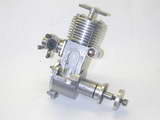
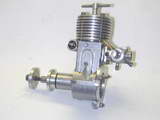
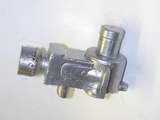
|
This 5cc side-port diesel is the work of Tasmanian builder, Tony Gray. Tony likes big, old R/C models so he developed the engine to turn a correspondingly big prop, be easy starting, docile, and inexpensive. The forward located exhaust "T" allows the oily diesel exhaust to be easily pipes away from the airframe and the rear mounted throttle simplifies the linkage hookup. I like the practical prop retention screw too. Tony does his own castings in aluminium dies using recycled automotive parts (helps to own a motor garage and wrecking yard!) |
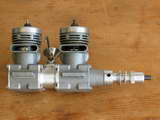
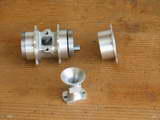
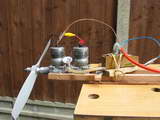
|
Yes, it's a Double Dooling made by MEN Member, Dick Roberts in the UK. Dick sent the photos after reading about the Vlatvan Twin features here a while back. Dick's engine is alternate firing and he reports that it makes quite a lovely noise! With the rather restricted choke fitted, he reports that it churns out about 1.3 BHP at 13,500 rpm. |